The Integration of Lean and Resilience Paradigms: A Systematic Review Identifying Current and Future Research Directions
Abstract
:1. Introduction
- What themes have been researched previously on the lean paradigm and its application to, and linkages with resilience?
- What are the research gaps and prospective research directions for the lean–resilience theme?
2. Materials and Methods
2.1. Selection of Databases, Search Criteria and Timing
2.2. Analysis and Synthesis
3. Results
3.1. Descriptive Analysis of Results
3.1.1. Sources and Number of Articles per Year and per Journal or/Conference
3.1.2. Research Methods Applied in the Articles
3.1.3. Sectoral and Geographical Analysis
3.1.4. Bibliometric Analysis of Findings
4. Discussion
4.1. Concept Map for Lean Resilience
4.1.1. Compatibility between Lean and Resilience
4.1.2. Integration of Lean and Resilience Paradigms
4.1.3. Impact of Lean and Resilience Paradigms
4.1.4. Application of Lean and Resilience Paradigms
4.1.5. Future Research Paths
5. Conclusions
Author Contributions
Funding
Data Availability Statement
Conflicts of Interest
References
- Bosher, L. Built-in Resilience through Disaster Risk Reduction: Operational Issues. Build. Res. Inf. 2013, 42, 240–254. [Google Scholar] [CrossRef] [Green Version]
- Bryce, C.; Ring, P.; Ashby, S.; Wardman, J.K. Resilience in the Face of Uncertainty: Early Lessons from the COVID-19 Pandemic. J. Risk Res. 2020, 23, 880–887. [Google Scholar] [CrossRef]
- Zavitsas, K.; Zis, T.; Bell, M.G. The Impact of Flexible Environmental Policy on Maritime Supply Chain Resilience. Transp. Policy 2018, 72, 116–128. [Google Scholar] [CrossRef] [Green Version]
- Soliman, M.; Saurin, T.; Anzanello, M.J. The Impacts of Lean Production on the Complexity of Socio-technical Systems. Int. J. Prod. Econ. 2018, 197, 342–357. [Google Scholar] [CrossRef]
- Ivanov, D. Viable Supply Chain Model: Integrating Agility, Resilience and Sustainability Perspectives—Lessons from and Thinking beyond the COVID-19 Pandemic. Ann. Oper. Res. 2020, 2020, 1–21. [Google Scholar] [CrossRef]
- Purvis, L.; Spall, S.; Naim, M.; Spiegler, V. Developing a Resilient Supply Chain Strategy during ‘Boom’ and ‘Bust’. Prod. Plan. Control 2016, 27, 579–590. [Google Scholar] [CrossRef]
- Ivanov, D.; Dolgui, A. Low-Certainty-Need (LCN) Supply Chains: A New Perspective in Managing Disruption Risks and Resilience. Int. J. Prod. Res. 2019, 57, 5119–5136. [Google Scholar] [CrossRef] [Green Version]
- Ahmed, W.; Rashdi, M.Z. Understanding the Influence of Lean and Agile Strategies on Creating Firms’ Supply Chain Risk Management Capabilities. Compet. Rev. 2020. [Google Scholar] [CrossRef]
- Dalziell, E.P.; McManus, S.T. Resilience, Vulnerability, and Adaptive Capacity: Implications for System Performance. 2004. Available online: https://ir.canterbury.ac.nz/handle/10092/2809 (accessed on 12 September 2020).
- Wedawatta, G.; Ingirige, B.; Amaratunga, D. Building up Resilienc e of Construction Sector Smes and their Supply Chains to Extreme Weather Events. Int. J. Strat. Prop. Manag. 2010, 14, 362–375. [Google Scholar] [CrossRef] [Green Version]
- Namdar, J.; Li, X.; Sawhney, R.; Pradhan, N. Supply Chain Resilience for Single and Multiple Sourcing in the Presence of Disruption Risks. Int. J. Prod. Res. 2018, 56, 2339–2360. [Google Scholar] [CrossRef] [Green Version]
- Yilmaz Borekci, D.; Rofcanin, Y.; Gürbüz, H. Organisational Resilience and Relational Dynamics in Triadic Networks: A Multiple Case Analysis. Int. J. Prod. Res. 2015, 53, 6839–6867. [Google Scholar] [CrossRef]
- Ivanov, D.; Dolgui, A. Viability of Intertwined Supply Networks: Extending the Supply Chain Resilience Angles towards Survivability. A Position Paper Motivated by COVID-19 Outbreak. Int. J. Prod. Res. 2020, 58, 2904–2915. [Google Scholar] [CrossRef] [Green Version]
- Shah, R.; Ward, P.T. Defining and Developing Measures of Lean Production. J. Oper. Manag. 2007, 25, 785–805. [Google Scholar] [CrossRef]
- Aziz, R.F.; Hafez, S.M. Applying Lean Thinking in Construction and Performance Improvement. Alex. Eng. J. 2013, 52, 679–695. [Google Scholar] [CrossRef] [Green Version]
- Womack, J.P.; Jones, D.T.; Roos, D. The Machine That Changed the World: The Story of Lean Production—Toyota’s Secret Weapon in the Global Car Wars That Is Now Revolutionizing World Industry; Simon and Schuster: New York, NY, USA, 2007. [Google Scholar]
- Ogunbiyi, O.; Goulding, J.S.; Oladapo, A. An Empirical Study of the Impact of Lean Construction Techniques on Sustainable Construction in the UK. Constr. Innov. 2014, 14. [Google Scholar] [CrossRef]
- Issa, U.H. Implementation of Lean Construction Techniques for Minimizing the Risks Effect on Project Construction Time. Alex. Eng. J. 2013, 52, 697–704. [Google Scholar] [CrossRef] [Green Version]
- Babalola, O.; Ibem, E.O.; Ezema, I.C. Implementation of Lean Practices in the Construction Industry: A Systematic Review. Build. Environ. 2019, 148, 34–43. [Google Scholar] [CrossRef]
- Järvenpää, E.; Lanz, M. Lean Manufacturing and Sustainable Development. Responsib. Consum. Prod. 2020, 423–432. [Google Scholar] [CrossRef]
- Abualfaraa, W.; Salonitis, K.; Al-Ashaab, A.; Ala’raj, M. Lean-Green Manufacturing Practices and their Link with Sustainability: A Critical Review. Sustainability. 2020, 12, 981. [Google Scholar] [CrossRef] [Green Version]
- Henao, R.; Sarache, W.; Gómez, I. Lean Manufacturing and Sustainable Performance: Trends and Future Challenges. J. Clean. Prod. 2019, 208, 99–116. [Google Scholar] [CrossRef]
- Seuring, S.; Müller, M. From a Literature Review to a Conceptual Framework for Sustainable Supply Chain Management. J. Clean. Prod. 2008, 16, 1699–1710. [Google Scholar] [CrossRef]
- Webster, J.; Watson, R.T. Analyzing the Past to Prepare for the Future: Writing a Literature Review. MIS Q. 2002, 26, xiii. [Google Scholar]
- Fink, A. Conducting Research Literature Reviews: From the Internet to Paper; Sage Publications: Thousand Oaks, CA, USA, 2019. [Google Scholar]
- Dresch, A.; Lacerda, D.P.; Antunes, J.A.V. Design Science Research: A Method for Science and Technology Advancement, 2015th ed.; Springer: Berlin, Germany, 2015. [Google Scholar]
- Tranfield, D.; Denyer, D.; Smart, P. Towards a Methodology for Developing Evidence-Informed Management Knowledge by Means of Systematic Review. Br. J. Manag. 2003, 14, 207–222. [Google Scholar] [CrossRef]
- Saunders, M.; Lewis, P.; Thornhill, A. Research Methods for Business Students; Pearson Education: London, UK, 2009. [Google Scholar]
- Garza-Reyes, J.A. Lean and Green—A Systematic Review of the State of the Art Literature. J. Clean. Prod. 2015, 102, 18–29. [Google Scholar] [CrossRef] [Green Version]
- Falagas, M.E.; Pitsouni, E.I.; Malietzis, G.; Pappas, G. Comparison of PubMed, Scopus, Web of Science, and Google Scholar: Strengths and Weaknesses. FASEB J. 2007, 22, 338–342. [Google Scholar] [CrossRef]
- Wang, Q.; Waltman, L. Large-Scale Analysis of the Accuracy of the Journal Classification Systems of Web of Science and Scopus. J. Inf. 2016, 10, 347–364. [Google Scholar] [CrossRef] [Green Version]
- Hollnagel, E.; Woods, D.D.; Leveson, N. Resilience Engineering: Concepts and Precepts; Ashgate Publishing, Ltd.: Farnham, UK, 2006. [Google Scholar]
- Shoaf, C.; Genaidy, A.; Karwowski, W.; Huang, S.H. Improving Performance and Quality of Working Life: A Model for Organizational Health Assessment in Emerging Enterprises. Hum. Factors Ergon. Manuf. 2003, 14, 81–95. [Google Scholar] [CrossRef]
- Rousseau, D.M. The Oxford Handbook of Evidence-Based Management; Oxford University Press: Oxford, UK, 2012. [Google Scholar]
- Wears, R.L.; Hollnagel, E.; Braithwaite, J. Resilient Health Care, Volume 2: The Resilience of Everyday Clinical Work; Ashgate Publishing, Ltd.: Hampshire, UK, 2015. [Google Scholar]
- Johnson, M.A.; Simmons, W.M.; Sullivan, P. Lean Technical Communication: Toward Sustainable Program Innovation; Routledge: Oxford, UK, 2017. [Google Scholar]
- Bombelli, A. Integrators’ Global Networks: A Topology Analysis with Insights into the Effect of the COVID-19 Pan-demic. J. Trans. Geogr. 2020, 87, 102815. [Google Scholar] [CrossRef] [PubMed]
- White, M.D.; Marsh, E. Content Analysis: A Flexible Methodology. Libr. Trends 2006, 55, 22–45. [Google Scholar] [CrossRef] [Green Version]
- Moher, D.; Liberati, A.; Tetzlaff, J.; Altman, D.G.; Prisma Group. Preferred Reporting Items for Systematic Reviews and Meta-Analyses: The PRISMA Statement. PLoS Med. 2009, 6, e1000097. [Google Scholar] [CrossRef] [PubMed] [Green Version]
- Thomas, J.; Harden, A. Methods for the Thematic Synthesis of Qualitative Research in Systematic Reviews. BMC Med. Res. Methodol. 2008, 8, 45. [Google Scholar] [CrossRef] [Green Version]
- Booth, A.; Sutton, A.; Papaioannou, D. Systematic Approaches to a Successful Literature Review, 1st ed.; Sage Publications Ltd.: London, UK, 2016; pp. 245–267. [Google Scholar]
- Slack, N.; Chambers, S.; Johnston, R. Operations Management; Pearson Education: London, UK, 2010. [Google Scholar]
- Hills, M. Assuring Organisational Resilience with Lean Scenario-Driven Exercises. Int. J. Emerg. Serv. 2015, 4, 37–49. [Google Scholar] [CrossRef]
- De Sanctis, I.; Meré, O.J.; Ciarapica, F.E. Resilience for Lean Organisational Network. Int. J. Prod. Res. 2018, 56, 6917–6936. [Google Scholar] [CrossRef]
- Das, K. Integrating Lean, Green, and Resilience Criteria in a Sustainable Food Supply Chain Planning Model. Int. J. Math. Eng. Manag. Sci. 2019, 4, 259–275. [Google Scholar] [CrossRef]
- Grijalva, P.; Eseonu, C. A tool to assess continuous improvement culture: Adapting SERVQUAL scale to measure employee satisfaction, and identify factors of success. In Proceedings of the International Annual Conference of the American Society for Engineering Management, Charlotte, NC, USA, 26–29 October 2016; pp. 1–10. [Google Scholar]
- Fitzgerald, B.; Stol, K.-J. Continuous Software Engineering and Beyond: Trends and Challenges. In Proceedings of the 1st International Workshop on Real World Domain Specific Languages, Barcelona, Spain, 12 March 2016; pp. 1–9. [Google Scholar]
- Maslaric, M.; Backalic, T.; Nikolicic, S.; Mircetic, D. Assessing the Trade-Off between Lean and Resilience through Supply Chain Risk Management. Int. J. Ind. Eng. Manag. 2013, 4, 229–236. [Google Scholar]
- Carvalho, H.; Cruz-Machado, V. Lean, Agile, Resilient and Green Supply Chain: A Review. In Proceedings of the 3rd International Conference on Management Science and Engineering Management, Bangkok, Thailand, 2–4 November 2009; pp. 66–76. [Google Scholar]
- Ruiz-Benítez, R.; López, C.; Real, J.C. The Lean and Resilient Management of the Supply Chain and its Impact on Performance. Int. J. Prod. Econ. 2018, 203, 190–202. [Google Scholar] [CrossRef]
- Rosso, C.B.; Saurin, T.A. The Joint Use of Resilience Engineering and Lean Production for Work System Design: A Study in Healthcare. Appl. Ergon. 2018, 71, 45–56. [Google Scholar] [CrossRef]
- Dynes, S.; Johnson, M.E.; Andrijcic, E.; Horowitz, B. Economic Costs of Firm-Level Information Infrastructure Failures. Int. J. Logist. Manag. 2007, 18, 420–442. [Google Scholar] [CrossRef] [Green Version]
- Schafer, D.; Abdelhamid, T.S.; Mitropoulos, P.; Howell, G.A. Resilience engineering: A new paradigm for safety in lean construction systems. In Proceedings of the 16th Annual Conference of the International Group for Lean Construction, Manchester, UK, 16–18 July 2008; pp. 16–18. [Google Scholar]
- Saurin, T.A.; Sanches, R.C. Lean construction and resilience engineering: Complementary perspectives of variability. In Proceedings of the 22nd Annual Conference of the International Group for Lean Construction, Oslo, Norway, 25–27 June 2014; pp. 61–71. [Google Scholar]
- Govindan, K.; Azevedo, S.G.; Carvalho, H.; Machado, V. Lean, Green and Resilient Practices Influence on Supply Chain Performance: Interpretive Structural Modeling Approach. Int. J. Environ. Sci. Technol. 2015, 12, 15–34. [Google Scholar] [CrossRef] [Green Version]
- Benítez, R.R.; López, C.; Real, J.C. Environmental Benefits of Lean, Green and Resilient Supply Chain Management: The Case of the Aerospace Sector. J. Clean. Prod. 2017, 167, 850–862. [Google Scholar] [CrossRef]
- Bhattacharya, A.; Cheffi, W.; Dey, P.K.; Thomas, A.; Byard, P.; Francis, M. Profiling the Resiliency and Sustainability of UK Manufacturing Companies. J. Manuf. Technol. Manag. 2016, 27. [Google Scholar] [CrossRef]
- Puchkova, A.; Srinivasan, R.; McFarlane, D.; Thorne, A. Towards Lean and Resilient Production; Elsevier: Amsterdam, The Netherlands, 2015. [Google Scholar]
- Khanra, S.; Dhir, A.; Mäntymäki, M. Big Data Analytics and Enterprises: A Bibliometric Synthesis of the Literature. Enterp. Inform. Syst. 2020, 14, 737–768. [Google Scholar] [CrossRef]
- Emrouznejad, A.; Marra, M. The State of the Art Development of AHP (1979–2017): A Literature Review with a Social Network Analysis. Int. J. Prod. Res. 2017, 55, 6653–6675. [Google Scholar] [CrossRef] [Green Version]
- Kazemi, N.; Modak, N.; Govindan, K. A Review of Reverse Logistics and Closed Loop Supply Chain Management Studies Published in IJPR: A Bibliometric and Content Analysis. Int. J. Prod. Res. 2019, 57, 4937–4960. [Google Scholar] [CrossRef] [Green Version]
- Azadeh, A.; Yazdanparast, R.; Zadeh, S.A. Performance Optimization of Integrated Resilience Engineering and Lean Production Principles. Expert Syst. Appl. 2017, 84, 155–170. [Google Scholar] [CrossRef] [Green Version]
- Ramirez-Peña, M.; Sotano, A.J.S.; Pérez-Fernandez, V.; Abad, F.J.; Batista, M. Achieving a Sustainable Shipbuilding Supply Chain under I4.0 Perspective. J. Clean. Prod. 2020, 244, 118789. [Google Scholar] [CrossRef]
- López, C.; Ruiz-Benítez, R. Multilayer Analysis of Supply Chain Strategies’ Impact on Sustainability. J. Purch. Supply Manag. 2020, 26, 100535. [Google Scholar] [CrossRef]
- Caldera, H.; Desha, C.; Dawes, L. Evaluating the Enablers and Barriers for Successful Implementation of Sustainable Business Practice in ‘Lean’ SMEs. J. Clean. Prod. 2019, 218, 575–590. [Google Scholar] [CrossRef]
- Tan, W.J.; Zhang, A.N.; Cai, W. A Graph-Based Model to Measure Structural Redundancy for Supply Chain Resilience. Int. J. Prod. Res. 2019, 57, 6385–6404. [Google Scholar] [CrossRef]
- Nunes-Vaz, R.; Arbon, P.; Steenkamp, M. Imperatives for Health Sector Decision-Support Modelling. Int. J. Disaster Risk Reduct. 2019, 38, 101234. [Google Scholar] [CrossRef]
- Lotfi, M. Which Practices are Lean, Agile and Resilient? Literature Review and Practitioners’ Perspective. Int. J. Adv. Oper. Manag. 2019, 11, 142–170. [Google Scholar]
- Paul, S.K.; Asian, S.; Goh, M.; Torabi, S.A. Managing Sudden Transportation Disruptions in Supply Chains under Delivery Delay and Quantity Loss. Ann. Oper. Res. 2019, 273, 783–814. [Google Scholar] [CrossRef] [Green Version]
- Ahmed, W.; Huma, S. Impact of Lean and Agile Strategies on Supply Chain Risk Management. Total. Qual. Manag. Bus. Excel. 2021, 32, 33–56. [Google Scholar] [CrossRef]
- Rajesh, R. On Sustainability, Resilience, and the Sustainable–Resilient Supply Networks. Sustain. Prod. Consum. 2018, 15, 74–88. [Google Scholar] [CrossRef]
- Lotfi, M.; Saghiri, S. Disentangling Resilience, Agility and Leanness. J. Manuf. Technol. Manag. 2018, 29, 168–197. [Google Scholar] [CrossRef] [Green Version]
- Rachid, B. Supply Chain Improvement in LARG (Lean, Agile, Resilient, Green) Context: A Risk Management Approach. In Proceedings of the 2017 6th IEEE International Conference on Advanced Logistics and Transport (ICALT), Bali, Indonesia, 24–27 July 2017; pp. 212–220. [Google Scholar]
- Villalba-Diez, J.; de Sanctis, I.; Ordieres-Meré, J.; Ciarapica, F.E. Lean Structural Network Resilience; Springer: Berlin, Germany, 2017. [Google Scholar]
- Zarrin, M.; Azadeh, A. Simulation Optimization of Lean Production Strategy by Considering Resilience Engineering in a Production System with Maintenance Policies. Simulation 2016, 93, 49–68. [Google Scholar] [CrossRef]
- Fitzgerald, B.; Stol, K.-J. Continuous Software Engineering: A Roadmap and Agenda. J. Syst. Softw. 2017, 123, 176–189. [Google Scholar] [CrossRef]
- Peñaloza, G.A.; Formoso, C.T.; Saurin, T.A. Safety Performance Measurement Systems Based on Resilience Engineering: A Literature Review. In Proceedings of the 25th Annual Conference of the International Group for Lean Construction (IGLC), Heraklion, Greece, 9–12 July 2017; pp. 903–910. [Google Scholar]
- Azevedo, S.G.; Carvalho, H.; Cruz-Machado, V. LARG Index A Benchmarking Tool for Improving the Leanness, Agility, Resilience and Greenness of the Automotive Supply Chain. Benchmark. Int. J. 2016, 23, 1472–1499. [Google Scholar] [CrossRef]
- Birkie, S.E. Operational Resilience and Lean: In Search of Synergies and Trade-Offs. J. Manuf. Technol. Manag. 2016, 27, 185–207. [Google Scholar] [CrossRef]
- Gao, L. Collaborative Forecasting, Inventory Hedging and Contract Coordination in Dynamic Supply Risk Management. Eur. J. Oper. Res. 2015, 245, 133–145. [Google Scholar] [CrossRef]
- Govindan, K.; Azevedo, S.G.; Carvalho, H.; Cruz-Machado, V. Impact of Supply Chain Management Practices on Sustainability. J. Clean. Prod. 2014, 85, 212–225. [Google Scholar] [CrossRef]
- Carvalho, H.; Azevedo, S. Trade-Offs among Lean, Agile, Resilient and Green Paradigms in Supply Chain Management: A Case Study Approach; Springer: Berlin/Heidelberg, Germany, 2014; pp. 953–968. [Google Scholar]
- Rolo, A.; Pires, A.R.; Saraiva, M. Supply Chain as a Collaborative Virtual Network Based on LARG Strategy; Springer: Berlin/Heidelberg, Germany, 2014. [Google Scholar]
- Resurreccion, J.Z.; Santos, J.R. Uncertainty Modeling of Hurricane-Based Disruptions to Interdependent Economic and Infrastructure Systems. Nat. Hazards 2013, 69, 1497–1518. [Google Scholar] [CrossRef]
- Saurin, T.A.; Rooke, J.; Koskela, L.; Kemmer, S. Guidelines for the Management of Complex Socio-Technical Systems: An Exploratory Study of a Refurbishment Project. In Proceedings of the 21th Annual Conference of the International Group for Lean, Fortaleza, Brazil, 29 July–2 August 2013. [Google Scholar]
- Thomas, A.; Francis, M.; John, E.; Davies, A. Identifying the Characteristics for Achieving Sustainable Manufacturing Companies. J. Manuf. Technol. Manag. 2012, 23, 426–440. [Google Scholar] [CrossRef]
- Birkie, S.E.; Trucco, P.; Kaulio, M. State-of-the-Art Review on Operational Resilience: Concept, Scope and Gaps. In Lecture Notes in Control and Information Sciences; Springer: Berlin/Heidelberg, Germany, 2013; pp. 273–280. [Google Scholar]
- Li, H.-H.J.K.; Tan, K.H.; Hida, A. Sustaining Growth in Electronic Manufacturing Sector: Lessons from Japanese Mid-Size EMS Providers. Int. J. Prod. Res. 2011, 49, 5415–5430. [Google Scholar] [CrossRef]
- Soni, U.; Jain, V. Minimizing the Vulnerabilities of Supply Chain: A new Framework for Enhancing the Resilience. In Proceedings of the 2011 IEEE International Conference on Industrial Engineering and Engineering Management, Changchun, China, 3–5 September 2011; pp. 933–939. [Google Scholar]
- Benefield, R. Agile Deployment: Lean Service Management and Deployment Strategies for the SaaS Enterprise. In Proceedings of the 2009 42nd Hawaii International Conference on System Sciences, Washington, DC, USA, 5–8 January 2009; pp. 1–5. [Google Scholar]
- Carvalho, H.; Duarte, S.; Machado, V. Lean, Agile, Resilient and Green: Divergencies and Synergies. Int. J. Lean Six Sigma 2011, 2, 151–179. [Google Scholar] [CrossRef]
- Mojtahedi, S.M.H.; Oo, B.L. Possibility of Applying Lean in Post-Disaster Reconstruction: An Evaluation Study. In Proceedings of the 20th Annual Conference of the International Group for Lean Construction (IGLC 20), San Diego, CA, USA, 18–20 July 2012. [Google Scholar]
- Demirkesen, S. Investigating the Synergy between Lean Construction Practices and Post Disaster Management Processes. Chall. J. Struct. Mech. 2020, 6, 23. [Google Scholar] [CrossRef]
- Womack, J.P.; Jones, D.T. Lean Thinking—Banish Waste and Create Wealth in your Corporation. J. Oper. Res. Soc. 1997, 48, 1148. [Google Scholar] [CrossRef]
- Koskela, L. Application of the New Production Philosophy to Construction; Technical Report, No. 72; CIFE: Nice, France; Stanford University: Stanford, CA, USA, 1992; p. 81. [Google Scholar]
- Koskela, L.J. Moving on-beyond Lean Thinking. Lean Constr. J. 2004, 1, 24–37. [Google Scholar]
- Ballard, G. Cycle time reduction in home building. In Proceedings of the 9th Annual Conference of the International Group for Lean Construction, Kent Ridge, Singapore, 6–8 August 2001; pp. 6–8. [Google Scholar]
- Hines, P.; Holweg, M.; Rich, N. Learning to Evolve. Int. J. Oper. Prod. Manag. 2004, 24, 994–1011. [Google Scholar] [CrossRef] [Green Version]
- Bhamra, R.; Dani, S.; Burnard, K. Resilience: The Concept, a Literature Review and Future Directions. Int. J. Prod. Res. 2011, 49, 5375–5393. [Google Scholar] [CrossRef]
- Wehbe, F.; Al Hattab, M.; Hamzeh, F. Exploring Associations between Resilience and Construction Safety Performance in Safety Networks. Saf. Sci. 2016, 82, 338–351. [Google Scholar] [CrossRef]
- Beamon, B.M. Measuring Supply Chain Performance. Int. J. Oper. Prod. Manag. 1999, 19, 275–292. [Google Scholar] [CrossRef]
- Chavez, R.; Gimenez, C.; Fynes, B.; Wiengarten, F.; Yu, W. Internal Lean Practices and Operational Performance. Int. J. Oper. Prod. Manag. 2013, 33, 562–588. [Google Scholar] [CrossRef]
- Prajogo, D.; Oke, A.; Olhager, J. Supply Chain Processes. Int. J. Oper. Prod. Manag. 2016, 36, 220–238. [Google Scholar] [CrossRef]
- Rushton, A.; Croucher, P.; Baker, P. The Handbook of Logistics and Distribution Management: Understanding the Supply Chain; Kogan Page Publishers: London, UK, 2014. [Google Scholar]
- Koskela, L.; Howell, G.; Ballard, G.; Tommelein, I. The Foundations of Lean Construction. Design and Construction. Build. Value 2002, 291, 211–226. [Google Scholar]
- Dubey, R.; Gunasekaran, A. The Sustainable Humanitarian Supply Chain Design: Agility, Adaptability and Alignment. Int. J. Logist. Res. Appl. 2016, 19, 62–82. [Google Scholar] [CrossRef]
- Cozzolino, A.; Rossi, S.; Conforti, A. Agile and Lean Principles in the Humanitarian Supply Chain: The Case of the United Nations World Food Programme. J. Humani. Logist. Supply Chain Manag. 2012, 2. [Google Scholar] [CrossRef]
- Oloruntoba, R.; Gray, R. Humanitarian Aid: An Agile Supply Chain? Supply Chain Manag. Int. J. 2006, 11. [Google Scholar] [CrossRef] [Green Version]
- Yazdani, M.; Mojtahedi, M.; Loosemore, M. Enhancing Evacuation Response to Extreme Weather Disasters Using Public Transportation Systems: A Novel Simheuristic Approach. J. Comput. Des. Eng. 2020, 7, 195–210. [Google Scholar] [CrossRef]
- Khalili, S.M.; Babagolzadeh, M.; Yazdani, M.; Saberi, M.; Chang, E. A Bi-Objective Model for Relief Supply Location in Post-Disaster Management; Institute of Electrical and Electronics Engineers (IEEE): New Jersey, NJ, USA, 2016; pp. 428–434. [Google Scholar]
- Behl, A.; Dutta, P. Humanitarian Supply Chain Management: A Thematic Literature Review and Future Directions of Research. Ann. Oper. Res. 2019, 283, 1001–1044. [Google Scholar] [CrossRef]
- Upadhyay, A.; Mukhuty, S.; Kumari, S.; Garza-Reyes, J.A.; Shukla, V. A Review of Lean and Agile Management in Humani-Tarian Supply Chains: Analysing the Pre-Disaster and Post-Disaster Phases and Future Directions. Prod. Plan. Control 2020, 1–14. [Google Scholar] [CrossRef]
- Agee, J. Developing Qualitative Research Questions: A Reflective Process. Int. J. Qual. Stud. Educ. 2009, 22, 431–447. [Google Scholar] [CrossRef] [Green Version]


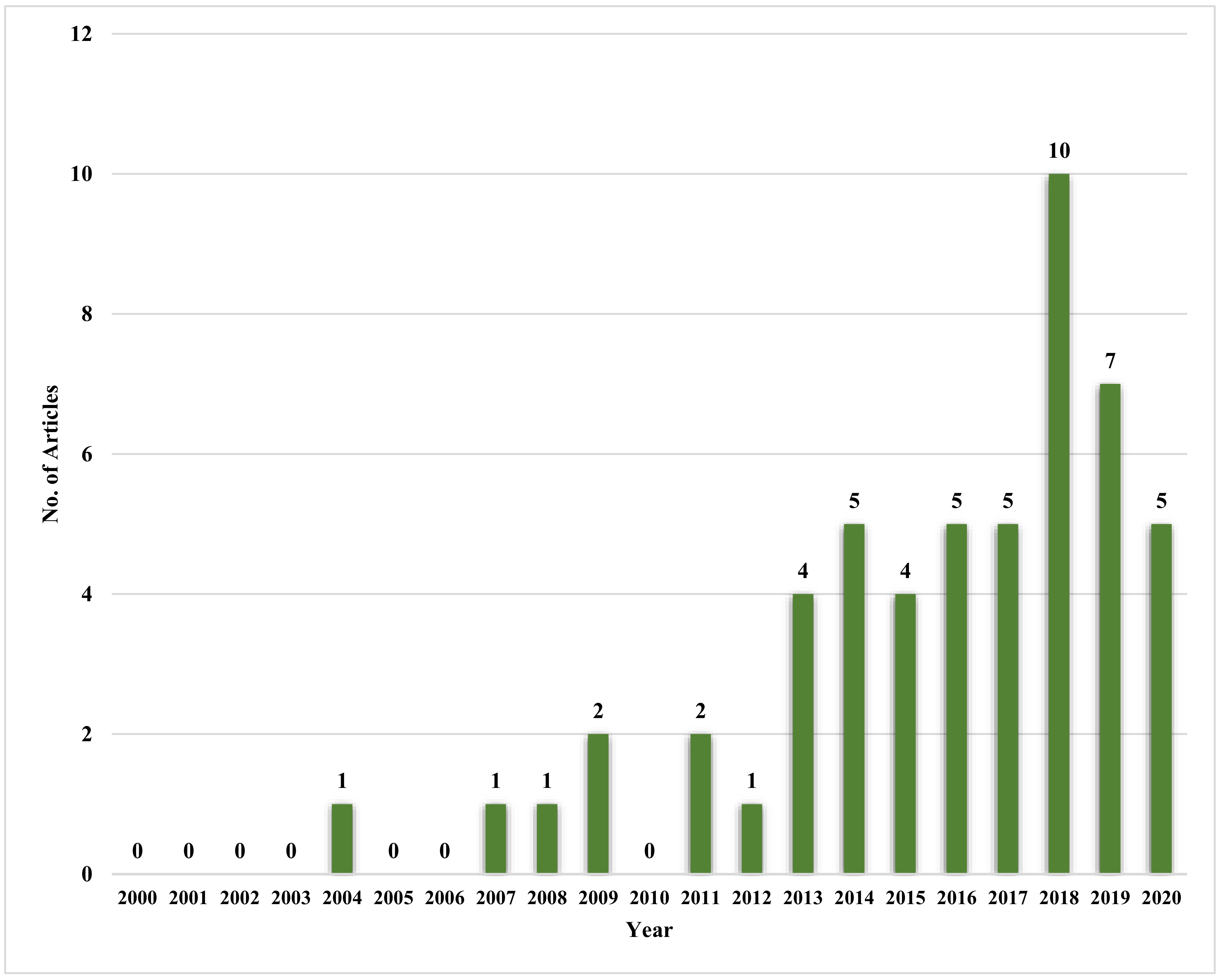
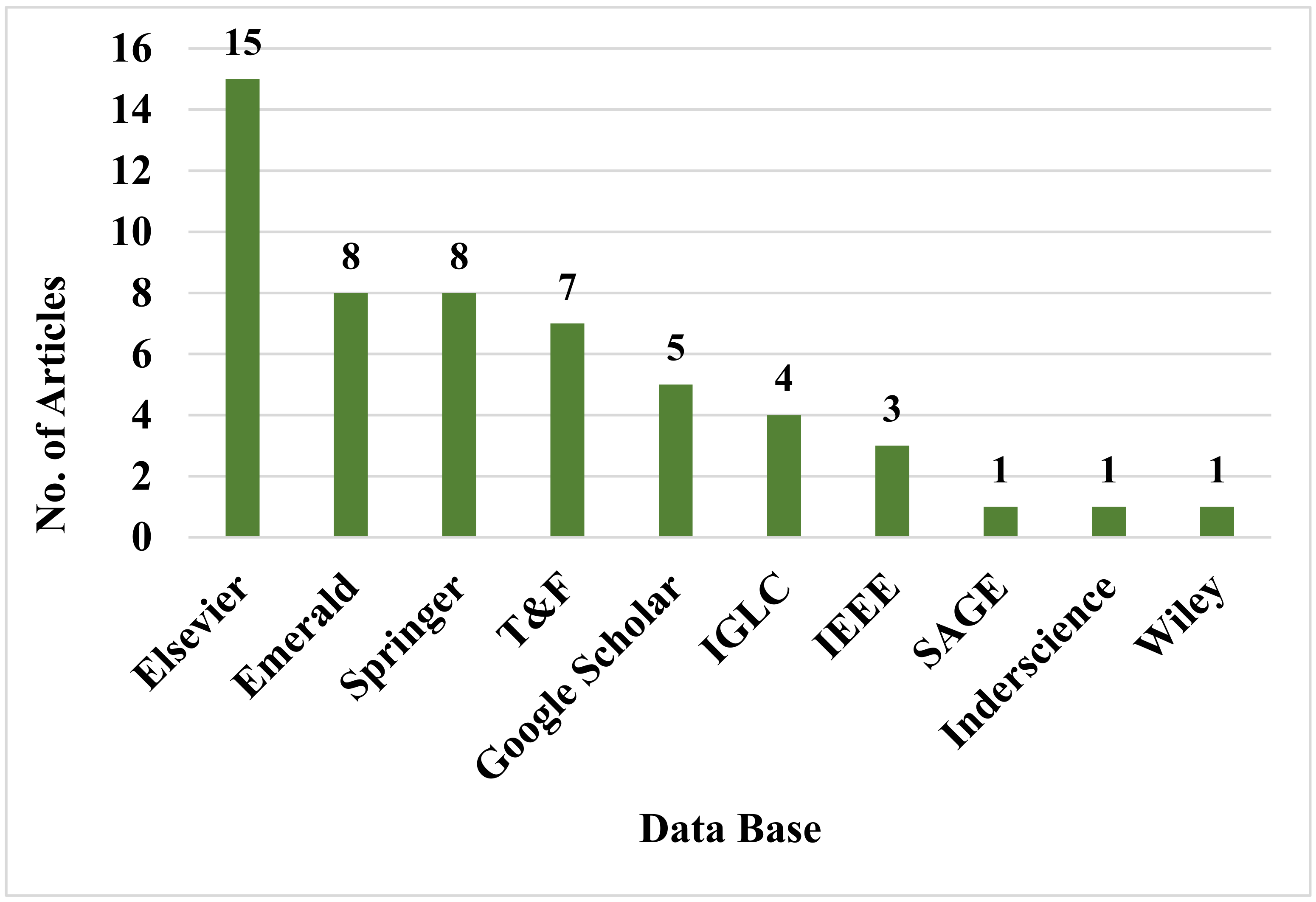
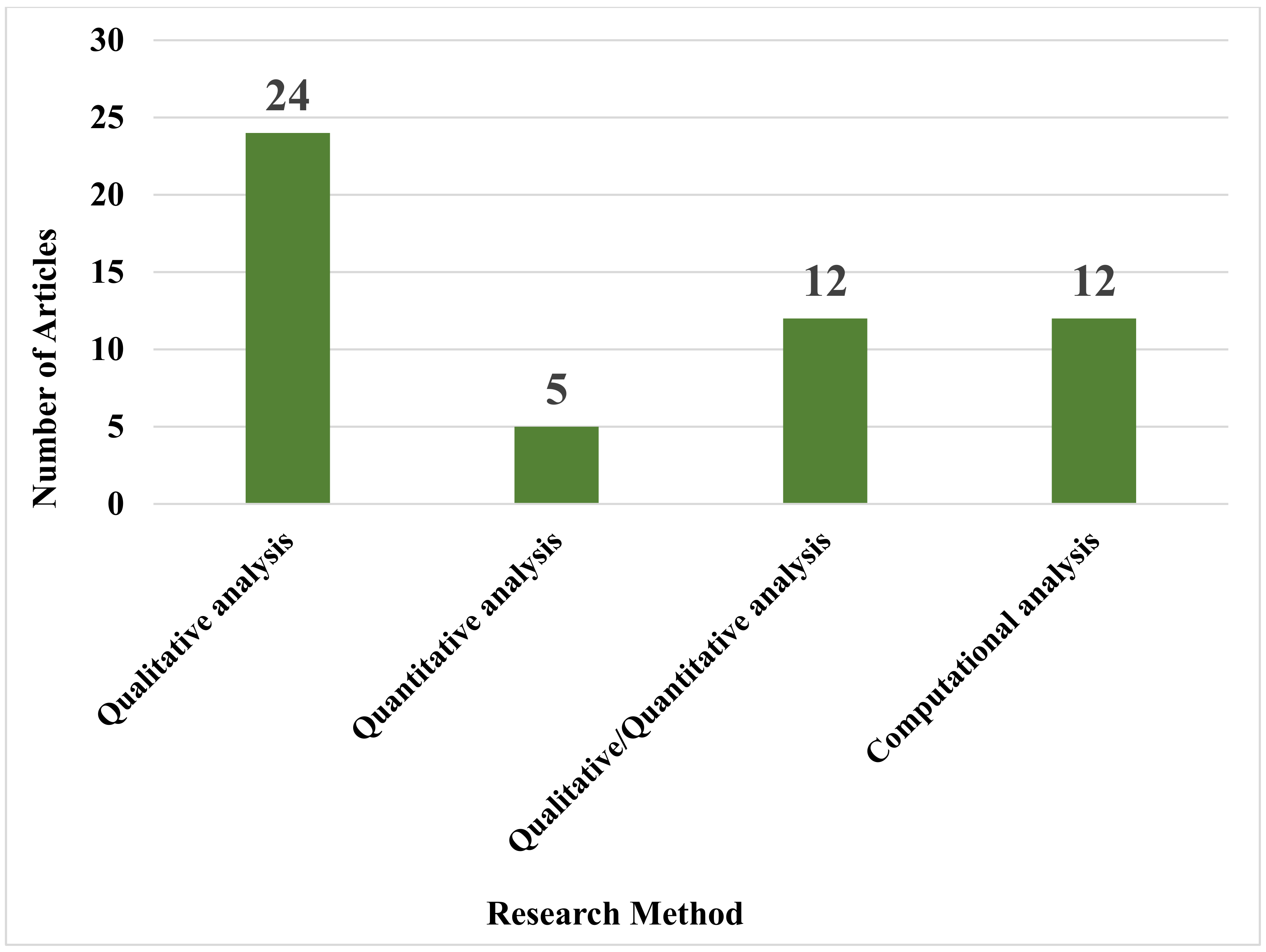

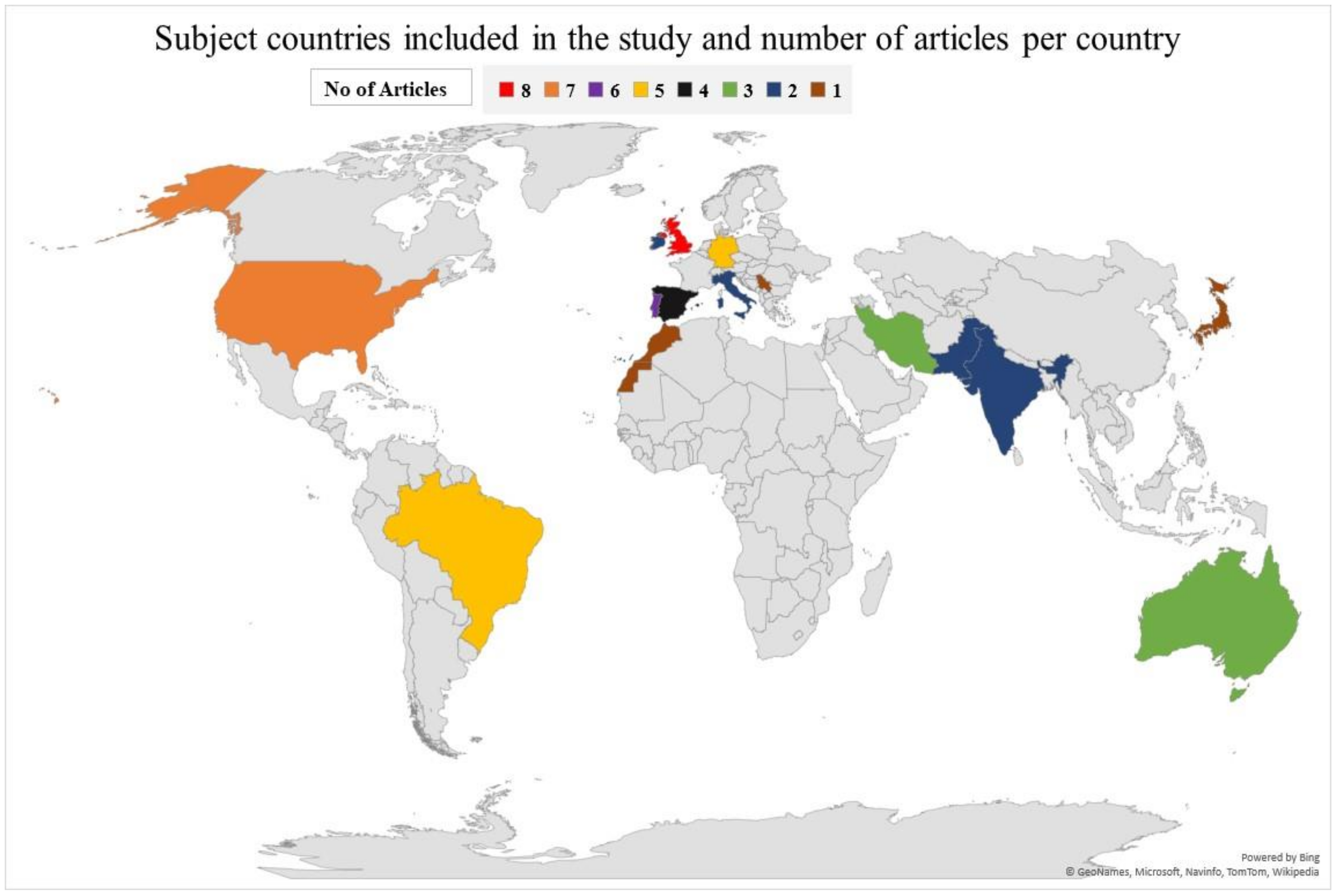

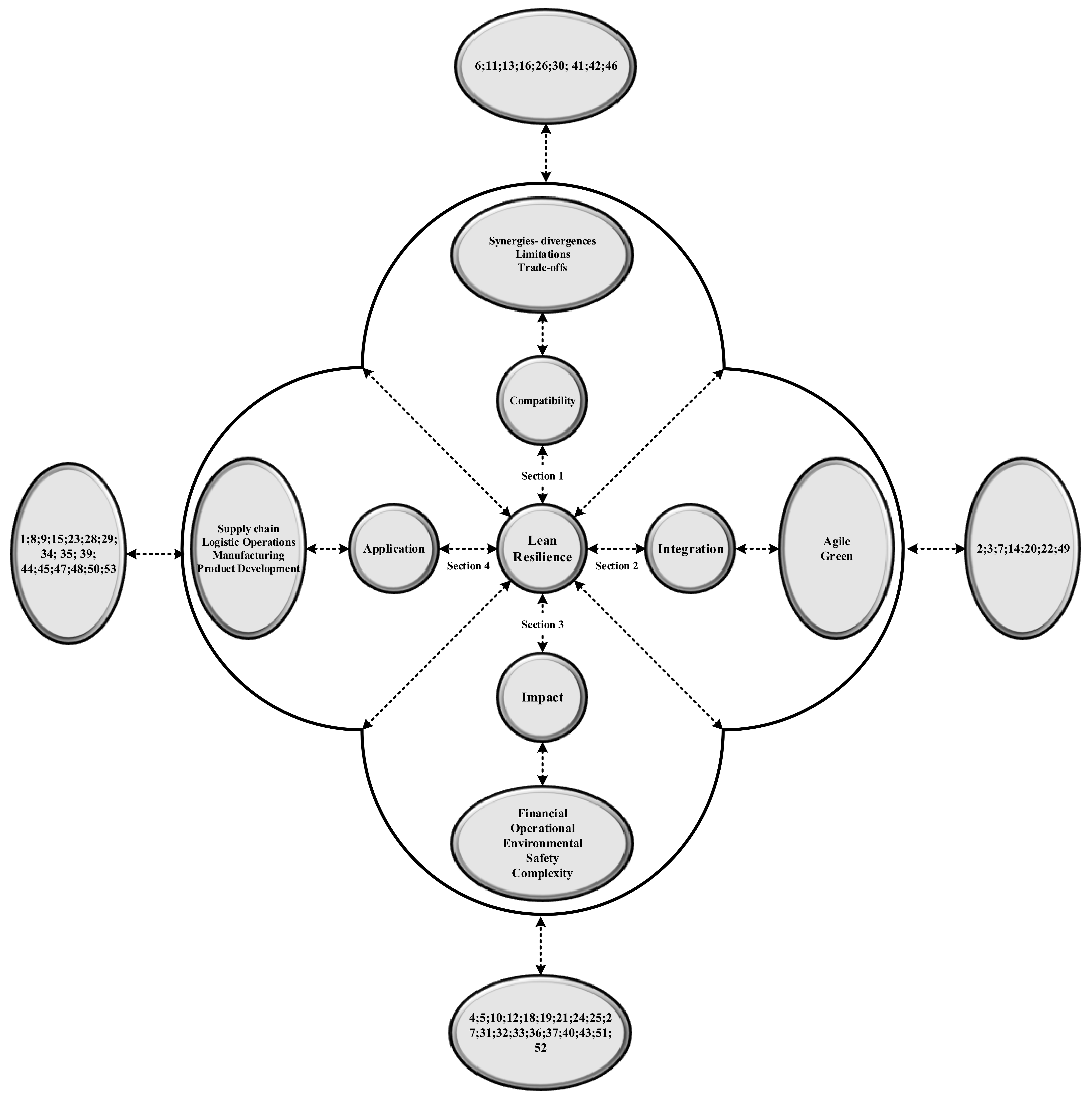
| Articles | Classification | No of Articles | Distribution Ratio |
|---|---|---|---|
| Lean and resilience selected articles n = 53 | Conceptual Relationship | 26 | 49% |
| Supply Chain | 16 | 30% | |
| Operation/Process | 11 | 21% |
| Journal | No. of Articles | Percentage |
|---|---|---|
| International Journal of Production Research | 4 | 10 |
| Journal of Cleaner Production | 4 | 10 |
| Journal of Manufacturing Technology Management | 4 | 10 |
| International Journal of Production Economics | 2 | 5 |
| Annals of Operations Research | 2 | 5 |
| Applied Ergonomics; Benchmarking: An International Journal; Competitiveness Review; European Journal of Operational Research; Expert Systems with Applications; Human Factors and Ergonomics in Manufacturing; International Journal of Advanced Operations Management; International Journal of Disaster Risk Reduction; International Journal of Emergency Services; International Journal of Industrial Engineering and Management; International Journal of Mathematical, Engineering and Management Sciences; Journal of Purchasing and Supply Management; Journal of Systems and Software; Journal of Risk Research; Natural Hazards; International Journal of Environmental Science and Technology; Production Planning and Control; Simulation; Sustainable Production and Consumption; The International Journal of Logistics Management; Total Quality Management and Business Excellence; Transport Policy | 1 | 2 |
| Conference | No. of Articles | Percentage |
|---|---|---|
| IGLC: Annual Conference of the International Group for Lean Construction. | 4 | 10 |
| IEEE International Conference on Industrial Engineering and Engineering Management; IEEE International Conference on Advanced Logistics and Transport | 2 | 5 |
| Proceedings of the 5th International Conference on Information Control in Manufacturing; Proceedings of the 8th International Conference on Management Science and Engineering Management; Proceedings of the 6th International Conference on Complex Networks and Their Applications; Proceedings of the International Annual Conference of the American Society for Engineering Management; Proceedings of the 1st International Workshop on Rapid Continuous Software Engineering; Proceedings of the Third International Conference on Management Science and Engineering Management; Proceedings of the seventh international conference on management science and engineering management; IFIP International Conference on Advances in Production Management Systems; Proceedings of the 42nd Annual International Conference on System Sciences | 1 | 2 |
| Article No | Author(s) | Year | Initial Thematic Classification | Database |
|---|---|---|---|---|
| 1 | Ramirez-Peña et al. [63] | 2020 | Supply Chain | Elsevier |
| 2 | Ahmed and Rashdi [8] | 2020 | Conceptual Relationship | Emerald |
| 3 | Ivanov [5] | 2020 | Supply Chain | Springer |
| 4 | Bryce et al. [2] | 2020 | Operation/Process | T&F |
| 5 | López and Ruiz-Benítez [64] | 2020 | Supply Chain | Elsevier |
| 6 | Ivanov and Dolgui [7] | 2019 | Conceptual Relationship | T&F |
| 7 | Caldera et al. [65] | 2019 | Conceptual Relationship | Elsevier |
| 8 | Tan et al. [66] | 2019 | Operation/Process | T&F |
| 9 | Nunes-Vaz et al. [67] | 2019 | Conceptual Relationship | Elsevier |
| 10 | Das [45] | 2019 | Operation/Process | Google Scholar |
| 11 | Lotfi [68] | 2019 | Conceptual Relationship | Inderscience |
| 12 | Paul et al. [69] | 2019 | Operation/Process | Springer |
| 13 | Ruiz-Benítez et al. [50] | 2018 | Conceptual Relationship | Elsevier |
| 14 | Ahmed and Huma [70] | 2018 | Conceptual Relationship | T&F |
| 15 | Zavitsas et al. [3] | 2018 | Supply Chain | Elsevier |
| 16 | Rosso and Saurin [51] | 2018 | Operation/Process | Elsevier |
| 17 | Rajesh [71] | 2018 | Supply Chain | Elsevier |
| 18 | Soliman et al. [4] | 2018 | Conceptual Relationship | Elsevier |
| 19 | Sanctis et al. [44] | 2018 | Operation/Process | T&F |
| 20 | Lotfi and Saghiri [72] | 2018 | Conceptual Relationship | Emerald |
| 21 | Ruiz-Benitez et al. [56] | 2017 | Supply Chain | Elsevier |
| 22 | Rachid [73] | 2017 | Supply Chain | IEEE |
| 23 | Villalba-Diez et al. [74] | 2017 | Supply Chain | Springer |
| 24 | Azadeh et al. [62] | 2017 | Operation/Process | Elsevier |
| 25 | Zarrin and Azadeh [75] | 2017 | Operation/Process | SAGE |
| 26 | Fitzgerald and Stol [76] | 2017 | Conceptual Relationship | Elsevier |
| 27 | Peñaloza et al. [77] | 2017 | Conceptual Relationship | IGLC |
| 28 | Azevedo et al. [78] | 2016 | Supply Chain | Emerald |
| 29 | Purvis et al. [6] | 2016 | Conceptual Relationship | T&F |
| 30 | Birkie [79] | 2016 | Conceptual Relationship | Emerald |
| 31 | Bhattacharya et al. [57] | 2016 | Conceptual Relationship | Emerald |
| 32 | Grijalva [46] | 2016 | Conceptual Relationship | Google Scholar |
| 33 | Govindan et al. [55] | 2015 | Conceptual Relationship | Springer |
| 34 | Hills [43] | 2015 | Conceptual Relationship | Emerald |
| 35 | Gao [80] | 2015 | Supply Chain | Elsevier |
| 36 | Puchkova et al. [58] | 2015 | Operation/Process | Elsevier |
| 37 | Govindan et al. [81] | 2014 | Conceptual Relationship | Elsevier |
| 38 | Carvalho and Azevedo [82] | 2014 | Supply Chain | Springer |
| 39 | Saurin and Sanches [54] | 2014 | Conceptual Relationship | IGLC |
| 40 | Rolo et al. [83] | 2014 | Supply Chain | Springer |
| 41 | Fitzgerald and Stol [47] | 2014 | Conceptual Relationship | Google Scholar |
| 42 | Maslaric et al. [48] | 2013 | Supply Chain | Google Scholar |
| 43 | Resurreccion and Santos [84] | 2013 | Supply Chain | Springer |
| 44 | Saurin et al. [85] | 2013 | Conceptual Relationship | IGLC |
| 45 | Thomas et al. [86] | 2012 | Operation/Process | Emerald |
| 46 | Birkie et al. [87] | 2012 | Conceptual Relationship | Springer |
| 47 | Li et al. [88] | 2011 | Conceptual Relationship | T&F |
| 48 | Soni and Jain [89] | 2011 | Supply Chain | IEEE |
| 49 | Carvalho and Machado [49] | 2009 | Conceptual Relationship | Google Scholar |
| 50 | Benefield [90] | 2009 | Operation/Process | IEEE |
| 51 | Schafer et al. [53] | 2008 | Conceptual Relationship | IGLC |
| 52 | Dynes et al. [52] | 2007 | Supply Chain | Emerald |
| 53 | Shoaf et al. [33] | 2004 | Conceptual Relationship | Wiley |
| Attributes | Lean | Resilience | References |
|---|---|---|---|
| Waste elimination and efficient use of resources | * | [14,94] | |
| Continual improvement and implementation strategies | * | [14,95,96] | |
| Contingency plans | * | [6,79,91] | |
| Visibility (demand) | * | * | [68,82,91] |
| Just in time | * | [97,98] | |
| Inventory minimization | * | [97,98] | |
| Collaboration with suppliers | * | * | [68,82,91] |
| Total preventative maintenance (TPM) | * | [72,82] | |
| Readiness | * | [6,99,100] | |
| Respond (pre-event): increase robustness through introducing redundancy | * | [6,99,100] | |
| Respond (post-event): (network flexibility) | * | [6,99,100] | |
| Recover: utilize extra capacity during product maturity stage | * | [6,79,91] |
| Research Stream | Proposed Research Questions |
|---|---|
| Application |
|
| Compatibility between lean–resilience |
|
| Integration of lean–resilience with other approaches |
|
| Lean–resilience Impact on supply chain performance |
|
Publisher’s Note: MDPI stays neutral with regard to jurisdictional claims in published maps and institutional affiliations. |
© 2021 by the authors. Licensee MDPI, Basel, Switzerland. This article is an open access article distributed under the terms and conditions of the Creative Commons Attribution (CC BY) license (https://creativecommons.org/licenses/by/4.0/).
Share and Cite
Habibi Rad, M.; Mojtahedi, M.; Ostwald, M.J. The Integration of Lean and Resilience Paradigms: A Systematic Review Identifying Current and Future Research Directions. Sustainability 2021, 13, 8893. https://doi.org/10.3390/su13168893
Habibi Rad M, Mojtahedi M, Ostwald MJ. The Integration of Lean and Resilience Paradigms: A Systematic Review Identifying Current and Future Research Directions. Sustainability. 2021; 13(16):8893. https://doi.org/10.3390/su13168893
Chicago/Turabian StyleHabibi Rad, Mahyar, Mohammad Mojtahedi, and Michael J. Ostwald. 2021. "The Integration of Lean and Resilience Paradigms: A Systematic Review Identifying Current and Future Research Directions" Sustainability 13, no. 16: 8893. https://doi.org/10.3390/su13168893
APA StyleHabibi Rad, M., Mojtahedi, M., & Ostwald, M. J. (2021). The Integration of Lean and Resilience Paradigms: A Systematic Review Identifying Current and Future Research Directions. Sustainability, 13(16), 8893. https://doi.org/10.3390/su13168893







